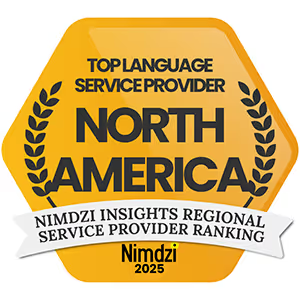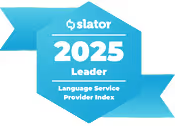A Spanish-speaking patient arrives in the emergency room with severe chest pain. Their partner tries to interpret for them but struggles with medical terminology. The doctor asks if the patient had “angina,” which the partner confuses with the Spanish “ansiedad,” meaning anxiety. This miscommunication leads to an initial treatment for a panic attack instead of a potential heart attack.
If you work in a clinic or hospital, you have likely seen language gaps affect care. Language barriers are one of the biggest obstacles to quality health care. If you don’t understand the onset, duration, magnitude, frequency and location of signs and symptoms, you cannot evaluate, diagnose or treat patients. If your patient does not understand their diagnosis, medication instructions, or treatment plan, their health is at risk. Addressing communication challenges allows you to do your job and improves patient outcomes and satisfaction. Accurate communication and adherence to Hispanic cultural considerations also help health care facilities meet legal and ethical obligations.
Understanding the Hispanic Patient Demographic
The Hispanic community is the largest ethnic minority in the United States. This group represents 18.9% of the total population and includes diverse nationalities, creating a rich mix in practices and forms of communication in health care:
- Language: The Hispanic community keeps Spanish, the second most used spoken language in the U.S., alive in this country. Since effective communication is crucial in health care, providing language access services, including written translations and professional medical interpretation services like video remote interpreting (VRI), is key to ensuring accurate, timely communication.
- Familial involvement: Family plays an important role in Hispanic culture. Engaging family members in their native language (Spanish, English or others) during consultations can show respect for cultural values, leading to more comprehensive care plans where patients will be more likely to follow medical advice and show treatment compliance.
- Trust and respect: Encouraging open dialogue and demonstrating cultural sensitivity can create a more collaborative patient-provider relationship. For example, being able to explain procedures thoroughly and inviting questions can help lessen patient anxiety.
- Health beliefs: Acknowledging and discussing traditional remedies that some Hispanic patients may prefer can help encourage them to stick to prescribed medical regimens. For example, health care professionals can offer guidance on potential interactions with prescribed medications.
The Importance of Medical Interpretation Services
Imagine a Spanish-speaking patient visiting your facility with a family member who interprets for them. While well-intentioned, untrained interpreters can cause miscommunications, potentially compromising patient safety. Using language services ensures medical information is accurate while reducing the risk of errors and maintaining patient confidentiality.
Hispanic access to health care is quite low, with many Hispanic or Latino people using public health insurance. This is why federal laws require health care providers to offer language assistance to patients with limited English proficiency (LEP). Failing to do so can lead to legal penalties and subpar patient care. These laws include:
- Title VI of the Civil Rights Act: Any healthcare provider receiving federal funds must offer meaningful language access to LEP patients. This includes trained medical interpreters or translation services.
- The Affordable Care Act (ACA): Section 1557 of the ACA requires covered entities to offer free, timely, and accurate language services. This law also applies to organizations receiving federal funding.
- Ethical standards: The American Medical Association and The Joint Commission emphasize the importance of effective communication for patient safety. Miscommunication can lead to medication errors, poor patient outcomes, and misdiagnoses.
Communication Challenges

Simplifying medical jargon, even with visual aids, can help clarify technical terms in culturally relevant ways. Many Hispanic patients speak Spanish, but just like among English speakers, dialects and literacy levels vary. Some struggle with complex medical terms. For example, a patient may think that by taking antibiotics, his viral infection will resolve.
Be mindful of nonverbal cues — qualified interpreters will have insight here. A simple adjustment in approach can make patients feel more comfortable with their healthcare provider. Nonverbal communication, like body language, eye contact, and tone, carries different meanings across cultures. For instance, direct eye contact comes across as a sign of respect in the U.S. but can be seen as confrontational in some Hispanic cultures.
Overcoming Language Barriers
Healthcare teams need practical solutions to ensure they and their patients get clear, accurate information for diagnosis and treatment. All staff members can benefit from training to better understand one of their biggest patient demographics' cultural barriers to health care.
1. Cultural Sensitivity and Awareness Training
Cultural sensitivity is about understanding the values, beliefs, and traditions that shape a patient's healthcare decisions. Without proper training, providers may unknowingly create barriers that impact trust and adherence to treatment plans. When staff can recognize and adapt their communication according to cultural norms, they create a more welcoming and effective care environment for their Hispanic patients.
2. Community Engagement
Building relationships outside clinical settings can help break down barriers before they impact care. Partnering with local organizations can provide a platform to share health education. Hosting bilingual health fairs (or fairs in Spanish) can improve awareness and build trust in local healthcare services. In addition, training bilingual staff as community liaisons can make healthcare services feel more accessible. Finally, qualifying your bilingual staff allows them to provide language-concordant care as a form of language access.
3. Technology Solutions
Professional interpretation services like VRI ensure compliance and improve patient care. These professional interpreters can act as an extension of your team, as they are trained in medical terminology, confidentiality, and cultural nuances. VRI allows participants and interpreters to see each other in real time, which can improve accuracy and comfort. It can be used across different departments, making this a flexible solution for clinics, hospitals, and emergency rooms.
Why Trust Us?
With over 20 years of industry experience, Martti understands the difference a trained medical interpreter can make in healthcare. We offer more than 250 languages, including American Sign Language (ASL). With connection in under 20 seconds for most common languages, your team can communicate with LEP patients and families quickly and clearly.
We also adhere to healthcare-specific and international standards for safeguarding sensitive data. Your patients are assured of global data protection, which includes HIPAA and SOC 2. Using Martti services helps your facility align with essential regulations, including ADA, Title VI, and ACA Section 1557.
See the Difference with Martti
Addressing linguistic and cultural barriers in healthcare requires a proactive approach. By integrating professional interpretation services and embracing cultural competence, your team can deliver fair and effective care to Hispanic patients, ultimately improving health outcomes and patient satisfaction. VRI offers an immediate, reliable solution for health care teams. It provides real-time access to medically trained interpreters.
Martti interpretation integrates seamlessly with your EHR workflows, automating session documentation and simplifying access at competitive rates. It will help your staff save up to two minutes per patient encounter. Martti is used in pharmacies, clinics, hospitals, and community health centers. Multiple clients have reported their ability to close the language gap with this technology.
Contact us today to book a demo and start connecting with patients in a meaningful way.

Linked Sources
- https://latino.si.edu/learn/latino-history-and-culture/latino-history/latinos-latinas-us
- https://www.archives.gov/eeo/laws/title-vi
- https://www.federalregister.gov/documents/2024/05/06/2024-08711/nondiscrimination-in-health-programs-and-activities
- https://pmc.ncbi.nlm.nih.gov/articles/PMC9932446/
- https://www.martti.io/interpreters
- https://www.martti.io/integrations
- https://www.martti.io/case-studies
- https://www.martti.io/contact










